For several centuries, dating back to about 1750 B.C., fingerprints have been recognized as a method of identifying people. It was originally used primarily to establish ownership or identity, since a fingerprint is effectively a forge-proof signature. However, since the late nineteenth century, the most well-known use of fingerprinting has been in criminal forensics, where fingerprints lifted from surfaces at crime scenes or from pieces of evidence are used to place suspects at that location or with that object.
There are many methods of detecting fingerprints. The most well-known method is dusting for prints with powder (usually containing aluminum or carbon) and lifting them from the surface with adhesive tape. Another method involves blowing iodine crystals through a specialized glass tube (called a fumer) that vaporizes the crystals. If the fumer is aimed at a latent print, the iodine vapors will cause the prints to become temporarily visible. Silver nitrate can also be used to detect prints; when applied to paper with distilled water any existing prints will turn black.
In 1954, another method for detecting fingerprints started to see use: ninhydrin application. Ninhydrin is a chemical powder that is soluble in ethanol or acetone at room temperature. When a solution of ninhydrin is applied to fingerprints (usually via a simple spray bottle), the ninhydrin reacts with the amino acids that are present in fingerprint residue. The reaction causes the production of an intense purple dye called “Ruhemann’s purple” (see the above image for an example).
One of the downsides to ninhydrin application is that it can take valuable time. At room temperature, the reaction between ninhydrin and the latent amino acids can take up to several days. Fortunately, the application of heat and moisture can accelerate this process considerably. Our humidified incubators are perfect for ninhydrin application processes. Our chambers are capable of reaching temperatures of up to 50°C (122°F) with relative humidity up to 90%, conditions which reduces the reaction time from days to minutes. Our incubators use ultrasonic humidity generators, which run on normal tap water and can be fed from a reservoir on top of the chamber or plumbed to a water line. Our chambers are available with a wide range of accessories allowing them to be customized to specific needs.
For more information or to request a quote, see our Contact Us page or call us at (800) 998-0500.

